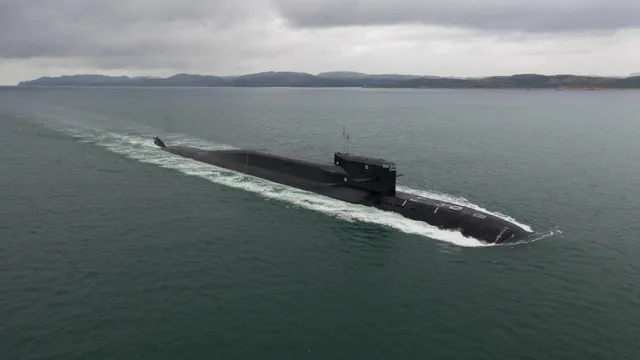
Royal Navy submarine sets record with 204 days at sea
2025-03-24 21:05- A Royal Navy nuclear-powered submarine returned to Scotland after spending 204 days at sea.
- This deployment surpassed the previous record of 201 days set in March and involved substantial strain on crew members.
- The return signifies a milestone for the Royal Navy, emphasizing both the achievements and challenges of extended submarine patrols.
Express your sentiment!
Insights
In the UK, a Royal Navy nuclear-powered submarine has returned home after a remarkable deployment lasting 204 days, breaking the previous record of 201 days at sea set just last March. This submarine, one of the four Vanguard-class vessels that form the backbone of the UK's nuclear deterrent strategy, set out from His Majesty's Naval Base (NMNB) Clyde in Faslane, Scotland, in late August. The extended nature of the deployment underscores the Royal Navy’s commitment to maintaining a continuous at-sea deterrent. Crew members of these vessels spend considerable time in isolation, entirely cut off from the outside world. The four Vanguard-class submarines, which include HMS Vanguard, HMS Victorious, HMS Vigilant, and HMS Vengeance, are designed to have unlimited endurance and range. Given their strategic importance, these submarines are expected to remain operational until the arrival of the new Dreadnought-class submarines in the early 2030s. However, the long deployments present challenges not only in operational efficiency but also in the strain on the crews and the vessels themselves. The last eight deterrent patrols have consistently exceeded five months. While longer deployments reduce the number of crew handovers and allow for more comprehensive post-patrol maintenance, they also result in increased pressure on both personnel and equipment. Sailors have reported difficulties during these extended missions, including being forced to share rations, which has raised concerns about their well-being. There were instances during the recent record-breaking deployment where crew members were provided with caffeine tablets due to fatigue concerns, which illustrated the potentially dire consequences of extended isolation at sea. The submarines play a vital role in the UK's continuous at-sea deterrent (CASD) strategy initiated in the 1960s, ensuring that at least one nuclear-armed submarine is patrolling undetected. This approach is a cornerstone of the UK’s defense policy, aimed at deterring aggression through a credible nuclear capability. As such, the return of the submarine after 204 days not only showcases a significant achievement for the Royal Navy but also highlights the immense pressures faced by personnel who dedicate long periods of their lives to the service.
Contexts
The history of the United Kingdom's continuous at-sea deterrent (CASD) strategy is a cornerstone of its national security policy, primarily centered around the deployment of a credible nuclear deterrent. This strategy emerged in the context of the Cold War, where the need for a reliable response to potential adversaries was paramount. Recognizing the implications of nuclear warfare, the UK adopted the CASD strategy to ensure a seamless and responsive deterrent capability, effectively preventing aggression against the nation and its allies. By maintaining a nuclear submarine patrolling the seas at all times, the UK aimed to demonstrate its commitment to defense and its willingness to respond decisively to threats. The establishment of the CASD policy can be traced back to the introduction of the Polaris submarine in the 1960s, which marked a significant advancement in the UK’s nuclear capabilities. The UK government decided to equip its fleet with nuclear-armed submarines, providing an assured second-strike capability that was essential to national defense. The subsequent transition to the Trident system in the late 1990s further bolstered this strategy, with Trident submarines providing enhanced stealth, range, and payload options. This evolution of deterrent technology was critical in countering potential nuclear threats from adversarial states, particularly during fluctuating global tensions. In addition to technological advancements, the CASD strategy has continually adapted to the changing geopolitical landscape. Post-Cold War, the focus shifted from direct confrontation with the Soviet Union to addressing new threats, including rogue states and terrorist organizations. The UK has emphasized the importance of maintaining a continuous deterrent amid these complexities, fostering international stability and contributing to global non-proliferation efforts. The commitment to CASD has also sparked debates about resource allocation, political ramifications, and the ethical dimensions of nuclear deterrence, prompting discussions on the future of the UK's nuclear arsenal. Looking ahead, the UK's CASD strategy remains a critical component of its defense posture. As global security dynamics continue to evolve, the UK is confronted with the necessity to reassess its nuclear capabilities and deterrent strategy while remaining committed to international security obligations. The current discussions about modernizing the Trident system, including the upcoming decisions on future investments and upgrades, suggest that the UK is prepared to maintain its CASD commitment into the foreseeable future. Ultimately, the history of the UK's continuous at-sea deterrent strategy reflects a steadfast resolve to safeguard national security and uphold its role as a responsible nuclear power.